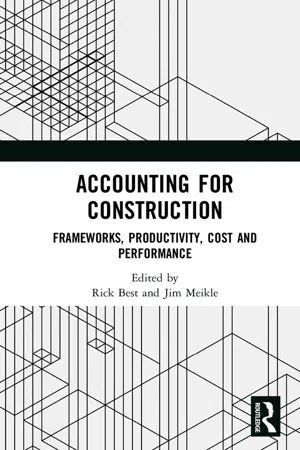Business
Measuring productivity
Measuring productivity involves assessing the efficiency of resources in generating goods or services. It typically involves calculating output per unit of input, such as labor hours or capital investment. By quantifying productivity, businesses can identify areas for improvement and make informed decisions to enhance their overall performance.
Written by Perlego with AI-assistance
Related key terms
Related key terms
1 of 4
Related key terms
1 of 3
11 Key excerpts on "Measuring productivity"
- eBook - ePub
Company Success in Manufacturing Organizations
A Holistic Systems Approach
- Ana M. Ferreras, Lesia L. Crumpton-Young(Authors)
- 2017(Publication Date)
- CRC Press(Publisher)
Since productivity is a relative measure, it is meaningful or useful to compare it to something. For example, businesses can compare their productivity values to that of similar firms or other departments within the same firm, or against past productivity data for the same firm or department (or even one machine). This approach allows firms to measure productivity improvement over time and/or the impact of certain decisions, such as new processes, equipment, and so on. Productivity is a required tool in evaluating and monitoring the performance of an organization, especially a manufacturing business. When directed at specific issues and problems, productivity measures can be very powerful. In essence, productivity measures are the yardsticks of effective resource use.Proper use of productivity measures can give the plant’s manager an indication of how to improve productivity: either increase the numerator of the measure, decrease the denominator, or both. Manufacturing leaders are concerned with how productivity measures relate to competitiveness and market leadership. If two firms have the same level of output, but one requires less input thanks to a higher level of productivity, that firm will be able to charge a lower price and increase its market share or charge the same price as the competitor and enjoy a larger profit margin. Productivity measures can be used to compare the firm’s performance to that of the industry, compare its performance with similar firms and competitors, compare performance among different departments within the firm, or compare the performance of the firm or individual departments within the firm with historical measures. Technology has been the major reason productivity has significantly increased in the manufacturing sector in the twenty-first century. As technology advances, manufacturing companies will continue to increase their productivity (Inman 2016). - eBook - ePub
- Kurt Heinze(Author)
- 2017(Publication Date)
- CRC Press(Publisher)
“Baskets,” which contain several activities, can be established on historical data. For example, the cost for the installation of a service water pump based on past performance will indicate how well the crew performs now.6.1.4 Measuring productivity
The basic concept of productivity is a ratio which relates some volume of output to some volume of input. It measures the use of resources or the degree of their use.PRODUCTIVITY =OUTPUT( units of products )INPUT( all types of resources )Input and output can be quantified in different ways. Assuming the process is learning by reading this text . You are putting into this process your existing knowledge . Your output would then be enhanced knowledge . Obviously, by just reading the text, you will retain only a part of the total knowledge contained in the text. We can measure this by writing an examination on the subject. This would be the feedback . Examination questions are established through experience and previous observation of performance. Those examination questions will becomestandards against which we measure performance.We now need units of measurement from no knowledge to total knowledge, say on a scale from 1 to 10. Assuming you have a knowledge ratio of 4 out of 10 when you start reading the text. The examination results indicate that you increased your knowledge ratio to 6 out of 10. This now leads us to the efficiency of your reading retaining skills, measured as output/input =6/4=1.5 or 50% increase in knowledge. How good is this? We do not know unless we compare it with an established standard of average performance, which may be 1.6 for all we know.The most common concept of productivity expresses output in physical units such as tons of steel, m3 of concrete, number of houses, km of road built. The difficulty here is that we cannot aggregate different units of output. We may, however, equate different units of quantity to dollars. In this case, constant dollars - eBook - ePub
Productivity Analysis
An Empirical Investigation
- Doris Yi-Hsin Wang(Author)
- 2018(Publication Date)
- Routledge(Publisher)
Kaplan [1983] suggests using productivity measures as supplements to traditional financial measures of manufacturing performance. In his view, management accountants would separate variances due to relative price changes from those caused by changes in production efficiency. Belcher [1984] also supports integrating productivity measurement into the process of analyzing and interpreting financial data. He recommends using productivity measurement as an important element of the performance evaluation process.ALTERNATIVE APPROACHES TO PRODUCTIVITY MEASUREMENT
In the economics literature productivity is usually defined as the ratio of output to input. Mundel [1983] defines productivity as a ratio of output produced per unit of resources consumed. Kendrick [1984] defines productivity as the ratio of output to inputs of labor and other resources, in real terms, at the company level. Sales revenues are used as this output measure, and all costs relating to the production of output, including inputs of material, labor, capital, and indirect business taxes, are measured as input costs. Productivity increases if the same output requires less input in the production process, or if the same input levels lead to increased output. Two distinct types of productivity ratios have been investigated in the literature, partial productivity ratios and total factor productivity ratios.Partial ProductivityPartial productivity measures are derived by dividing total output by a single input. The early productivity researchers were mainly concerned with the changing status of labor. The partial productivity index of labor, which is a ratio of output divided by labor cost, was one of the first indexes of productivity. Belcher [1984] proposes partial productivity measures for four inputs—material, labor, capital, and energy—because these four factors are the major inputs for producing output. Kendrick [1984] states that a company may use partial productivity ratios if only one or two inputs are the major inputs in its production processes.In fact, as noted in the next section where available models are discussed, partial productivity measures are criticized by many researchers. Belcher points out that one partial measure can be improved at the expense of another. For example, improvements in labor productivity may result from increases in capital investments. Mammone [1980a:37] thinks that a labor productivity index is unrealistic , stating that “the ratio of output to labor input may change for reasons unrelated to the quality of labor input.” Craig and Harris [1973] comment that the cost of generating increased labor productivity must be considered in evaluating manufacturing performance. Generally speaking, partial productivity measures are useful in certain circumstances, but they have the serious shortcoming that substitutions among inputs may affect the resulting output measures. - eBook - ePub
Accounting for Construction
Frameworks, Productivity, Cost and Performance
- Rick Best, Jim Meikle, Rick Best, Jim Meikle(Authors)
- 2019(Publication Date)
- Routledge(Publisher)
7 Measuring capital productivity in construction Michael ReganIntroduction
Productivity is the ratio of output to input in the production process and is a measure of the productive efficiency of the economy. Labour productivity measures output generated for each unit of labour input and, like capital productivity, is considered a partial productivity measure because of its reliance on a single input. Labour productivity is calculated for the economy as real gross domestic product (GDP) per hour worked.1 Capital productivity estimates are indicators of real GDP per unit of capital inputs or services used in production. Multifactor productivity (MFP) measures the amount of real output expressed in real value added from inputs of capital and labour.The most comprehensive measure of an economy’s productivity is MFP, which is the efficiency with which producers generate additional output from inputs of capital and labour (Productivity Commission 2015: 2). Growth in labour productivity captures improved labour efficiencies as well as the value added from growth in capital productivity through such mechanisms as research and development, technical progress and technology embodied in new plant and equipment. These environmental factors or externalities provide incremental output without the use of additional labour inputs. Investment in technical progress is central to both labour and capital productivity and directly affects MFP. Other externalities on the input side are the pricing of inputs, currency exchange rates (Productivity Commission 2016), public capital expenditures (Pereira and Roca-Sagales 1999; Abiad et al. 2015) and the utilisation of capital (Barnes 2011).On the output side, externalities in the case of commodity exports include exchange rate or commodity price volatility, shifts in demand or a downturn in the business cycle. If investment continues in order to complete projects commenced several years earlier and the value of output diminishes, productivity will decline. Other matters that may affect productivity on the output side include externalities such as mismatch of business and investment cycles (KPMG 2016) and change in the terms of trade (Productivity Commission 2014a, 2016). - eBook - ePub
Productivity in Indian Manufacturing
Measurements, Methods and Analysis
- Vinish Kathuria, Rajesh Raj S N, Kunal Sen(Authors)
- 2014(Publication Date)
- Routledge India(Publisher)
In the rest of the study we utilize factory-level (unit-level) data provided by the Annual Survey of Industries (ASI), the main source of information about the industry published by the Central Statistical Organization (CSO), Government of India. Further ahead this chapter critically evaluates the concepts of productivity and efficiency. Methodological issues in Measuring productivity and efficiency are also discussed. Then it tries to elucidate some inherent problems involved in the database and defines the variables used in empirical exercise of the study. Additionally, the distribution of jute mills by location in India is displayed before interpreting empirical results and the conclusion.Indices of Productivity and EfficiencyProductivity and efficiency, although closely related, are fundamentally different concepts. Productivity is the ratio of output to input, while inefficiency is the deviation of actual production from the optimum one. In this sense, inefficiency measures underutilization of productive capacity. Higher productivity does not necessarily imply greater efficiency excepting for under constant returns to scale. To measure average productivity of a firm, we do not need to know anything beyond the production point. The ratio of output to a single input provides partial information about input productivity. However, the productive performance of a firm cannot be captured fully by the measure of partial productivity of labour or capital or any single factor of production. To find out the cumulative influence of all interrelated factors on total output, one can utilize the concept of total factor productivity (TFP), a measure of output per unit of all inputs taken together. One popular way of measuring TFP is the estimation of a neoclassical production function.2 Such models assume that the production function is continuous, strictly increasing and quasi-concave.3In the neoclassical approach, the unique source of TFP growth is technical progress. Here, technical progress is defined as the residual of the contribution to output growth after accounting for the contributions made by different inputs, popularly known as ‘Solow residual’, and is originated by better capacity utilization and improved labour skills through learning-by-doing. Solow (1957) developed a methodology for estimating a residual measure (the difference between a weighted sum of the growth rates of capital and labour inputs and the growth rate of output where the weights are taken to be the share of these inputs in national income) from aggregative national income data by assuming that the production function in the economy follows constant returns to scale (CRS), capital and labour inputs are paid their marginal products, and technological change is Hicks-neutral so that shifts in the level of output do not change the marginal rates of substitution of the inputs. This measure of TFPG seems to be quite sensitive to the assumptions regarding returns to scale, level of capital utilization and so on. - eBook - ePub
Productivity in Singapore's Retail and Food Services Sectors
Contemporary Issues
- Mun Heng Toh, Shandre Thangavelu(Authors)
- 2016(Publication Date)
- WSPC(Publisher)
The most important of the remaining possible sources of influence on managerial decisions concerning possible improvements in productivity and technology is government. Over the long-run, the government seeks to promote a wide array of objectives, including reasonable economic growth, rising standard of living, development and effective utilization of resources, high employment level, the maintenance of a strongly competitive position in international trade and an attractive destination for foreign investments. It is recognized that productivity improvement in productivity and technological capabilities may offer major contributions towards achieving such objectives. It is also apparent that such improvements may entail negative effects on some of these objectives, at least in the short run. Government policies can affect prospective profitability of enterprises. Among the most influential of these are tax policies, regulatory restrictions, and, in some industries, the prevention of unfair competition from foreign producers.2. Revisions of Basic Concepts Among the most widely prevailing elements of the mythology relating to productivity, the following five may be the most important:(a) Productivity measures reflect changes in the ‘efficiency’ of production.(b) Changes in productivity are reasonably well measured by output per man-hour.(c) Increases in output per man-hour or output per unit of other inputs are invariably desirable because they yield decreases in unit costs and hence, tend to increase profitability.(d) Cost accounting analyses and management efforts to improve performance can be significantly improved by reliance on productivity measures that purport to compare the quantity of all inputs combined with the quantity of all output combined.(e) Prevailing productivity measures permit reasonably effective comparisons of productivity performance among all firms within an industry and even among different industries, as well as comparisons with performance levels in the past.2.1.Productivity and ‘efficiency’In contrast to physical science, there is lack of an economic concept of physical efficiency. There is absence of physical common denominators for combining the input contributions of labor energy and skills, various materials and suppliers and a wide array of technical and managerial activities. Nor are there important physical common denominators for combining the wide range of quality characteristics and service characteristics of output. - eBook - ePub
- Norman Frumkin(Author)
- 2015(Publication Date)
- Routledge(Publisher)
They are published in the monthly BLS journal, the Monthly Labor Review (www.bls.gov). There are two basic measures of productivity, labor productivity and multifactor productivity. Labor productivity data are provided quarterly and multifactor productivity data are provided annually. This chapter covers both labor and multifactor productivity for the business sector of the economy. Other topics include productivity and returns to scale, the productivity rebound that began in the mid-1990s, the effect on productivity of private industry spending to combat terrorism, and productivity and price change. METHODOLOGY OF Measuring productivity Productivity is the output of items produced in relation to the inputs required for the production of the items. 1 Mathematically, this is expressed as: Labor-Hour Productivity: Business Sector The broadest measure of labor productivity is the output of goods and services per hour worked in the business sector of the economy. Mathematically, labor productivity in the business sector is expressed as: Output is represented by the gross domestic product (GDP) in the business sector, adjusted for price change. Business GDP is smaller than the GDP, as described below. The GDP comprises the goods and services produced in the household, business, government, and international sectors of the economy (chapter 3). The GDP is defined on a value-added basis that covers the labor costs, depreciation costs on equipment and structures, business profits, interest, and sales and property taxes in producing the nation’s output. This excludes the purchases of intermediate goods and services from other industries. Otherwise, the intermediate items would result in continuous double-counting, with the production of the same goods and services being re-counted as they become components in successive stages of fabrication until they are incorporated in a final end-use item. For example, steel sheets are used in the manufacture of an automobile - eBook - ePub
Human Performance and Productivity
Volumes 1, 2, and 3
- Marvin D. Dunnette, Edwin A. Fleishman(Authors)
- 2014(Publication Date)
- Psychology Press(Publisher)
7. It may well be that a technical productivity index that concentrates on labor inputs and work outputs is not feasible. This is reflected in equation (7) that recognizes that output is a function of more than labor input. This is a recognition that, in modem technology, output is rarely, in either goods or services, a simple and direct result of what people do.Causation and Uses
Productivity measures are not collected just for the sake of collecting numbers. Like all measures, they must serve some purpose. Two issues are of importance here: (1) productivity measures as an indication of the causes of productivity decline or increase; and (2) productivity measures as tools for increasing employee productivity.1. Where productivity shows an increase or a decline one immediate question is: Why? Why is it, as shown in Tabie 2.1, that some industrial groups are showing marked increases in productivity, whereas others are in marked decline? One purpose of productivity assessment might weil be diagnostic; that is, the measurement should provide some indication of the reasons for productivity change. Unfortunately, all the available evidence points to a remarkable complexity in the specific determinants of labor productivity. In the most detailed analysis to date, Sutermeister (1976) has suggested some 33 possible determinants that may affect job productivity. These are roughly divided into such general categories as individual needs, physical conditions, social conditions, organizational variables, leadership, and so forth. And, it is very probable that for every real-life situation, many of these determinants are acting together in some unknown amounts.Trends in the literature appear to concentrate on single variables or small clusters of variables. For some years, there has been substantial interest in such items as: (1) job satisfaction and productivity (Dunn & Stephens, 1972); (2) quality of working life (Herrick, 1975); (3) consumer behavior and productivity [Lovelock & Young, 1979); (4) job redesign (Pritchard, Montagno, & Moore, 1978); (5) team pressures (Pepinsky, Pepinsky, & Pavlik, 1960); (6) environmental variables and productivity (Young & Berry, 1979), and so forth. What all these studies seem to indicate is that individual and team productivity is a very implicated matter. - eBook - ePub
Operational Excellence
Breakthrough Strategies for Improving Customer Experience and Productivity
- James Martin(Author)
- 2021(Publication Date)
- Productivity Press(Publisher)
7 Measuring and Improving Productivity Overview This chapter covers how to link higher-level financial goals to operational projects to increase productivity. Highly competitive organizations focus on increasing productivity and shareholder economic value added (EVA). They align organizational resources to achieve their strategies in a highly competitive global environment. This helps them achieve strategic goals. These goals are also carefully selected to increase customer experience metrics, such as net promoter score, which correlates to repeat purchase intentions, and customer satisfaction. The strategy is balanced to ensure customers, employees, and other stakeholders are represented in the operational projects that enable the organizational strategy. Organizational behaviors are driven by metrics that help identify productivity and operational improvement opportunities to increase productivity. These are aligned to “voice of,” financial, and operational metrics that provide a focus for resource alignment to ensure an organization works on things that will increase its competitive position over time. There are thousands of metrics that organizations and industries use to measure, manage, and improve their products, services, and supporting processes. Some are financial, others operational, and, depending on the goal, they focus on customer satisfaction, sustainability, and interests of other stakeholders. They can be aggregated into higher classifications, such as time, money, quality, sustainability, safety, and other types, or condensed into basic lists organizations use to manage their business. Table 7.1 lists some important financial metrics. These are business-level metrics and include shareholder EVA, which measures the profit in excess of return to shareholders (i.e., the net profit minus cost of capital), and return on equity (ROE) is the gain to shareholders over what they invested (i.e., the return on assets minus liabilities) - eBook - ePub
Measuring Construction
Prices, Output and Productivity
- Rick Best, Jim Meikle, Rick Best, Jim Meikle(Authors)
- 2015(Publication Date)
- Routledge(Publisher)
The manner in which productivity of the construction industry has been analysed over the years has been influenced by the manner in which productivity analysis more generally has developed. Structural reform in a variety of industries has encouraged researchers to study the productivity and efficiency performance of these industries. In undertaking these examinations, researchers have used a range of productivity and efficiency measurement techniques. In determining the productivity performance of a firm or industry, a range of indicators can be looked at. Utilities and government service providers, such as schools and hospitals, often operate in markets which lack prices and costs determined under competitive conditions. In these cases, the usual market indicators of performance, like profitability and rates of return, cannot be used to gauge a firm or industry’s economic performance accurately. It is possible that these financial indicators might be more an indication of the distortions themselves rather than of the performance of the firm or industry in question. In these circumstances, indicators of the level and change of productivity would be more appropriate indicators of performance. Although the construction industry is a relatively competitive one, a number of questions have been raised in the past regarding the degree to which prices and costs in the industry reflect their true economic worth. In these circumstances, therefore, productivity analysis can make a useful contribution to gauging the performance of the industry.In the past, productivity changes over time were first measured using an ‘index’ approach. This approach involves the construction of index numbers which can be used to indicate the partial or total factor productivity of an industry. Partial productivity measures generally relate a firm’s (or industry’s) output to a single input factor – for example, the volume of construction activity per employee is a labour-based partial productivity measure (see, for example, Cassimatis 1969; Briscoe 2006; Cremeans 1981; Ive and Gruneberg 2000: chapter 3 ; Pearce 2003: chapter 5 - eBook - ePub
Innovation in the Digital Economy
New Approaches to Management for Industry 5.0
- Agnieszka Rzepka, Agnieszka Rzepka(Authors)
- 2023(Publication Date)
- Routledge(Publisher)
14 Business productivity assessment Concepts and methods Jakub Bis, Borys Burkynskyi, Aleksander Prokopiuk, Valeriy Goryachuk, Oleksandr LaikoDOI: 10.4324/9781003384311-14Introduction and review of the literature
Topic of the article is important because business planning and management of the enterprise should be carried out on the basis of an objective assessment of the results of its activities. An inadequate assessment can disorient management and lead to subjectivity in making management decisions, significantly reduce management efficiency, and lead to negative consequences. In modern conditions, the availability of scientifically based methods and tools for assessing the performance of entrepreneurial activities is of high value, both from a research and management point of view. The originality of the article, comparing to previous researches, is that there is no generally accepted theoretical and methodological approach to the analysis and assessment of the productivity of entrepreneurial activity. In this regard, the development of new conceptual and methodological foundations for assessing the productivity of entrepreneurial activity is characterized by scientific novelty and practical importance.Speaking of the productivity of entrepreneurial activity, we mean the productivity of certain economic entities and legal entities engaged in entrepreneurial activity. The productivity of entrepreneurial activity depends on the combination of factors, among which the main ones are natural resources, the quality of human labor (intensity and dexterity), the volume and quality of means of production (fixed assets, technologies, etc.), intangible assets (patents, information technologies), the organization of production, the state of the business environment (regulatory policy of the state). Growing productivity allows businesses to produce more goods and offer greater service. This creates higher wages, supports economic growth, holds back inflation, and increases tax revenues.
Index pages curate the most relevant extracts from our library of academic textbooks. They’ve been created using an in-house natural language model (NLM), each adding context and meaning to key research topics.
Explore more topic indexes
Explore more topic indexes
1 of 6
Explore more topic indexes
1 of 4










